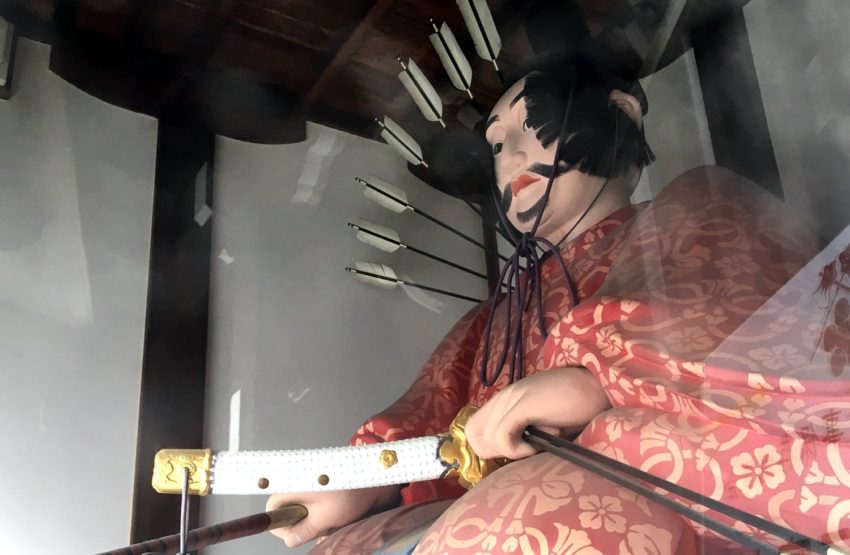The Japanese sword is known throughout the world for its excellence. While virtually everyone is familiar with the katana, not as many people are familiar with all of the other swords that were common in ancient Japan. In this article, we will attempt to take a broader look and show you how so many different Japanese war swords played important roles in the history of Japan.
Kofun Period War Swords of Japan
The Kofun period of Japanese history covers the years between 300 and 538 AD . It’s named for the extensive burial mounds that are associated with this culture. Unfortunately, there is a lot that remains unknown about the history of Japan during this time. However, some exquisite Japanese war swords have been recovered from these burial mounds.
Of particular interest is the large and bulbous pommel that is seen on many of these Kofun-era Japanese war swords. The natural assumption is that these pommels were intended as bludgeoning weapons. However, some archaeologists believe these swords to have been ceremonial.
When we look at these weapons, we see that there are two basic types. One is a double-edged broadsword, while the other is more like what some would call a chokutoCHOKUTO 直刀 "straight sword" learn more.... For those who don’t know, the chokuto is the straight-bladed version of the katana. Of the two, the chokuto type was probably more common. Its popularity lasted until the Mongol invasions of 1274 and 1281, when the Japanese learned a very hard lesson: A curved sword combined with a mounted rider is a pretty lethal combination.
As you may know, the Mongol invasions of Japan were stopped mainly by the weather. After such an apparently miraculous victory, Japanese warriors decided to learn from their enemies. By 800 AD, the out-of-fashion chokuto was seen as a weapon for bandits, rogues, and other assorted criminals.
Classical Period Japanese Swords
The “classical period” of Japan includes the Asuka, Nara, and Heian periods (539-1185 AD). During this time, the sword we know as the katana (along with its close cousins like the wakizashi) began to take shape. It was during this time that the samuraiSAMURAI 侍 "warrior serving a lord" learn more... class came into existence. Their dominance would continue for many centuries to come, and the katana quickly became their symbol.
The life and death of a samurai were deeply intertwined with his sword. When a member of the samurai class was born, a sword would be waiting for the male baby in the delivery room. When a samurai was laid to rest, it was done so with his sword at his side. From birth to death, a samurai was linked to his weapon as if it were a part of his body.
During this time, the many distinctive styles of Japanese swordsmanship developed. The mainstream methods were usually referred to as kenjutsuKENJUTSU 剣術 "the art of swords" learn more.... However, the iai style was also quite popular. Iai-jutsu (which is today known as iaidoIAIDO 居合道 "art of drawing a sword" learn more...) is the art of drawing the sword and killing the enemy with a single smooth motion. Essentially, it is a quickdraw style that aims for maximum efficiency and instant death for one’s enemies.
On the subject of styles, it would also be worth mentioning the niten-ichiryu, a style that emphasizes the use of the katana and wakizashi at the same time. This “two swords” method was invented by the famous samurai duellist Miyamoto Musashi. If you want to know how good he was, just consider this: he was a duellist, and he died of old age.
It is said that the first curved Japanese sword was created by a smith named Amakuni. According to legend, he became very distressed when his swords continuously broke in battle. He went nine days and nine nights without eating or drinking, focusing only on his efforts to create the perfect sword. It’s a good thing he didn’t forego sleep as well since it was a dream that finally revealed the answer.
Medieval Period Swords of Japan
The Japanese medieval period includes the Kamakura, Kenmu, and Muromachi periods. During this time, the sword continued to be an important symbol of samurai and imperial power. Remember, the sword of a samurai was considered to be a representation of his soul. To get an idea of just how important the sword was to the culture of this period, we need look no further than the life of Ashikaga Yoshiteru, the 13th ruler of the Ashikaga shogunate.
It was said that Yoshiteru was more like a samurai than an emperor. This emperor was well-known for his skills with the katana. He practiced every day, although it isn’t clear if he ever actually participated in any battles. In fact, Yoshiteru seems to have devoted most of his efforts to the creation of peace. While he reigned as shogunSHOGUN 将軍 "medieval military commander" learn more..., Japan enjoyed a relatively peaceful stretch.
However, there were some dark dealings behind the scenes that eventually resulted in Yoshiteru’s murder.
It is interesting to note that Yoshiteru was respected as a swordsman in spite of his lack of military experience. This is just one example of the fact that the sword has cultural importance in Japan. Some would say that this cultural importance is just as important as the practical aspect. Just as the sword represents the soul of the warrior, so too does the emperor represent the soul of the nation. In the modern era, where people no longer fight with Japanese war swords, this cultural and spiritual significance is more pronounced than ever.
Japanese War Swords and the Battle Of Sekigahara
The Battle Of Sekigahara, fought in 1600, was one of the last major battles of the samurai era, and easily one of the bloodiest. After the death of Oda Nobunaga, Japan was thrown into chaos. Although he was a brutal tyrant, Nobunaga had proven to be an effective administrator who was able to hold the country together (if only through fear). However, he was assassinated by his right-hand man, Akechi Mitsuhide.
No one knows why Mitsuhide chose to turn on his best friend and closest ally. However, it is known that Oda Nobunaga had made many enemies during his rise to power. Among those enemies were the ninjaNINJA 忍者 "stalking/hiding person" learn more... of the Iga region, whom he had once tried to eliminate. Considering that the ninja were famous for assassinations (among other things), it is fairly obvious what happened here.
After the death of Nobunaga, a lot of other people decided that they would like to be emperor. Thus, it all came to a head at the Battle of Sekigahara. Ieyasu Tokugawa, a man who had once fought at Nobunaga’s side, ended up as the big winner. His victory at Sekigahara ushered in a long period of peace and stability.
The sword played a huge role in this battle, as it would have been the primary means of close-range combat. However, this battle was complicated by the introduction of a new weapon: the gun. With gunpowder on the battlefield, the katana was no longer the most powerful weapon in play. That being said, the simple Tanegashima rifles of this period were not particularly accurate, and incredibly slow to load.
World War Two and Modern Japanese Swords
If you are educated about the history of this weapon to any extent, you have probably heard about the Japanese war swords that were carried by some Japanese soldiers during World War 2. For decades, people have passed around stories regarding Japan’s WW2 swords. Many people have repeated the old belief that these Japanese war swords could slice the barrel of a gun in two.
However, these stories are probably not based in reality. It is true that some Japanese soldiers (particularly officers) would carry and use the Katana in battle. However, most of these swords were not made by traditional methods. When you consider the intricate and labor-intensive process that is required to produce a true katana, you realize that such a weapon cannot easily be mass-produced.
This is not to say that the machine-made Japanese war swords from this period were poor-quality weapons. If you look at one of the many surviving examples, you can see that these were high-quality blades. However, many of them were officer’s blades that were mainly used for ceremonies. It is fair to say that most of the swords carried by Japanese soldiers in WW2 were never used for combat.
However, we shouldn’t forget the “banzai charge”.
The banzai charge was a suicidal tactic that involved many men drawing their blades and charging fearlessly into the face of certain death. In most cases, it was a suicidal move intended to bring an honorable death in battle, but sometimes the banzai charge would actually bring victory due to the surprising and unorthodox nature of the tactic.
Conclusion
Past and present, the sword has always been a symbol for Japan’s fighting spirit. A nation which prides itself on its martial history is naturally going to feel a special bond with its most distinctive weapon. The katana ruled the battlefield until the invention of the gun, and some would say it still rules the hearts and minds of those who continue the warrior traditions associated with its use.
This is why buying and collecting Japanese swords is still such a popular hobby. Newly-made swords can be very affordable but be of rather stunning high quality. The art continues to evolve, and now is a golden time for anyone interested in comparing, selecting, and owning a gorgeous Japanese war sword.
We hope that you have gained a new appreciation for the historical and cultural significance of this blade, as it is far more than a piece of metal. For those who understand its meaning, the katana and its brethren are representations of the Japanese warrior spirit and all of its accompanying virtues.

